Podcast: Download (Duration: 46:02 — 42.9MB)
Get Notified Of Future Episodes Apple Podcasts | Spotify | Amazon Music | Android | Blubrry | Gaana | TuneIn | Deezer | Anghami | RSS | More
Success in online business demands an ability to adapt. James and guest Charley Valher discuss the most recent changes in online marketing, particularly as surrounds the need to create video content, and how to move with those changes.
Our experts talk about the benefits of podcasting for business.
They look at the impact of AI content creation tools.
And James and Charley give tips for effective video content distribution.
Table of contents
1. The need to move with change
2. Where Charley is in his podcasting story
3. What’s shifted for James
4. The minimum standard that now applies
5. Why Charley targeted the Aussie market
6. Some observations on James’s show
7. A brief recap
8. Video domination in podcasting
9. Then add the other stuff
10. The impact of short videos
11. Picking your platforms
12. Does TikTok actually convert?
13. How will AI change things?
14. Why we still need humans
15. The stuff that won’t change
16. Wrapping things up
The need to move with change
James’s business model, a podcast with a recurring subscription product, has remained consistent for over a decade. He acknowledges, however, the need for innovation and adaptation in an ever-changing market, where new players emerge and social platforms change.
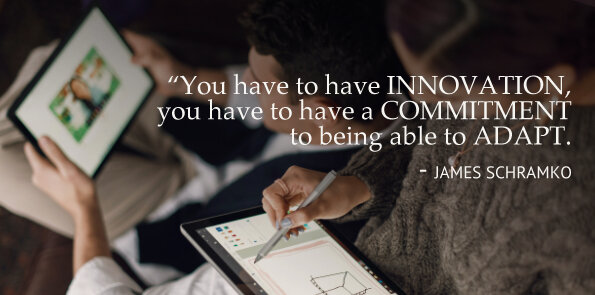
James also notes the AI revolution in creating content, moving towards content curation and prompt engineering, which provides more leverage in research and distribution.
That said, James isn’t typically the first to pioneer new things and risk failure. He prefers to wait for things to settle a bit and then join the early majority movement.
Where Charley is in his podcasting story
James considers the previous 1000 episodes of his podcast a sort of apprenticeship, and is excited to see the next mainstream phase of the show. Where is Charley in the podcasting game?
Some of James’s audience likely remember Charley running a media company, Valher Media. Charley still has the business today, but in addition has started two podcasts in the finance niche – Business and Investing, and Property and Investing.
Despite not having a large email list or established brand, Charley’s shows have reached a combined 50,000 hits in a month by taking advantage of what’s currently working in podcasting.
What’s shifted for James
James in his podcasting journey has experienced significant changes, including the adoption of high-quality sound and visuals as a minimum standard, which has become more important since the rise of video podcasts. He now only records podcasts when he has the facilities and quality necessary to produce a high-quality production, and Charley was largely instrumental in upgrading James’s equipment.
James reflects on the times when he had poor audio quality in the past – recording using a portable dictaphone, or with audible wind and traffic noise. He also mentions that this past December and January, he did not record any podcasts, marking the first year ever that he did not do so, as he was traveling overseas and did not have access to the minimum level of quality podcast facilities he required.
James expects setbacks and challenges to occur, and has had the occasional guest who could not bring the minimum recording quality required to the show, resulting in an unpublished episode.
The minimum standard that now applies
It’s not just James. Overall, the podcasting industry has evolved to require a higher minimum standard for content quality, including audio, video, and content standards.
James and Charley observe that grassroots audio-only podcasts find it difficult now to compete in the industry, and that quality is now essential to retain listeners.
There was a time when volume was the game. Now, however, audiences expect high quality content, with podcasting and YouTube channels becoming just as seriously evaluated as radio, TV shows, or movies. As a result, audiences are choosing to consume interviews and shows that look and sound better, with higher-quality production and content.
Why Charley targeted the Aussie market
James finds it interesting that Charley’s finance shows cater to a specifically Australian audience.
Charley acknowledges it might have seemed easier to grow a finance podcast if he had targeted the world. He felt, though, that Australians had been neglected in this space, and he wanted to create something unique for them.
This decision turned out to be an advantage for Charley’s shows because they became the only place where people could find this type of content. Charley thinks that many podcasts suffer from being too similar to other shows and that it’s crucial to be unique to have fast growth.
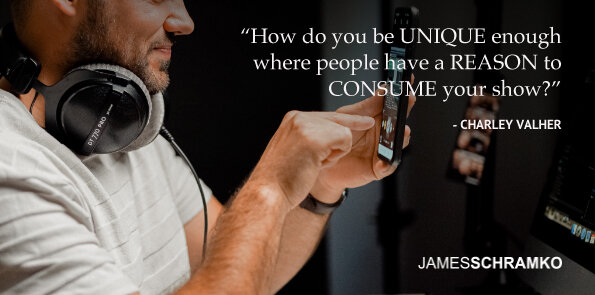
Some observations on James’s show
Differentiation has definitely crossed James’s mind as a podcaster. While he doesn’t consider himself as having a specialty, he does try to simplify what’s complicated, and to be direct, calling things as he sees them, and offering his own perspective on topics where he has experience in, such as selling, marketing, and leadership.
James also calls himself fussy – he values his audience’s time and does not want to waste it with subpar guests or episodes.
Charley offers his observation: he’s come to expect James will ask unique questions of his guests, and notes that he challenges his guests’ ideas, even if they align with his own.
James probes for the why, and adds insights from his own experience. In this way, he’s built up a loyal and trusting audience over the years.
A brief recap
James briefly runs over a few of the changes in the industry – the implementation of a minimum quality standard, and a broader acceptance of podcasts, as indicated by their greater accessibility.
People now know what podcasts are and can consume them easily from their smart devices. And if one hopes to compete in the vast sea of offerings, one should pick a point of differentiation and maintain a quality that will bring listeners back and make their shows referral-worthy.
Video domination in podcasting
When Charley first entered podcasting, the idea of video was something of a tough sell. Video now has become dominant in podcasting and is expanding even further, with social media platforms demanding video promotion tools.
Short video content has become an effective way to grow media presence – both James and Charley highlight the benefits of using clips from longer episodes for marketing purposes.
James emphasizes the importance of captioning and editing for maximum impact and mentions that short videos can actually help podcasts gain extra views and listens.
Then add the other stuff
The combination of video content and short clips is a powerful tool to grow visibility online, according to Charley and James. Add to that paid campaigns, direct messages, email follow-ups, and paid traffic-enhanced social media campaigns, and you have a strong recipe for success.
James has seen paid campaigns take advantage of built-up stock value in the market, resulting in customers coming on board for just a few cents.
That’s awesome, says Charley. Turning a podcast into tangible revenue and profits, after all, is the reason many people do media in general.
The impact of short videos
Short videos are making an impact, especially on YouTube.
Charley notes that creating a compelling cliffhanger in a short video can encourage viewers to watch a longer episode or clip, and YouTube’s shorts feed is growing in competition against platforms like TikTok and Instagram reels.
James has noticed a change in optimum strategy for posting short content on YouTube channels. It used to damage view time per video for long-form content, but it’s now acceptable and even recommended to post shorts on the same channel.
It goes to show, says James, that strategic readjustments are necessary every few years in the constantly evolving digital landscape.
Picking your platforms
Which platforms do our two experts prefer for marketing purposes?
James says he cuts off channels that do not give him a yield, such as Pinterest and TikTok, while Charley is happy to build assets on email lists, YouTube, and audio following platforms, but not on Facebook, Instagram, TikTok, Twitter, and LinkedIn – these later are most notable to change.
They both agree that OwnTheRacecourse, a concept of controlling one’s own assets, is important. James revisits his octopus and tentacles analogy, where the website or email list is the head of the octopus, and other platforms are the tentacles.
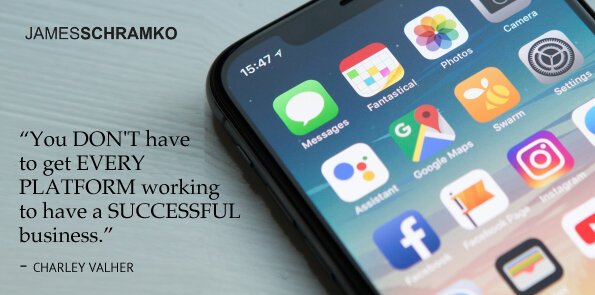
Does TikTok actually convert?
Oddly enough, while Charley wouldn’t build assets on Facebook and TikTok, these platforms have done well for him in terms of marketing to his niche.
Charley explains that TikTok does create buyers and has seen success for some markets, particularly in the coaching and education space, as well as for younger demographics. Where it may not be as effective is for older demographics or tight local or trade businesses.
His more typical clients, says James, are in their 30s and 40s, and while he hasn’t seen success on TikTok, he is open-minded to trying it again in the future if there is a significant shift. He emphasizes the importance of personal preference and taking note of what works for your business.
How will AI change things?
AI is the news of the moment, and James touches on the potential impact of AI on content creation. If everything from text to audio to imagery can be produced by AI, is there a possibility of AI-generated content dominating the industry?
To Charley’s mind, AI will instead improve the quality of content by providing, if you will, an Ironman suit for creators. He’s actually experimented with ChatGPT improving questions for his podcast, and the results have him excited.
Overall, he and James suggest a flexible strategy that can adapt to technological advancements is crucial for businesses to stay competitive in content creation.
Why we still need humans
Even with the rise of AI tools, James and Charley believe in the importance of a human element in content creation.
In Charley’s opinion, people value not just the topic, but also the person behind the content, and that people still look for emotional experiences like stories.
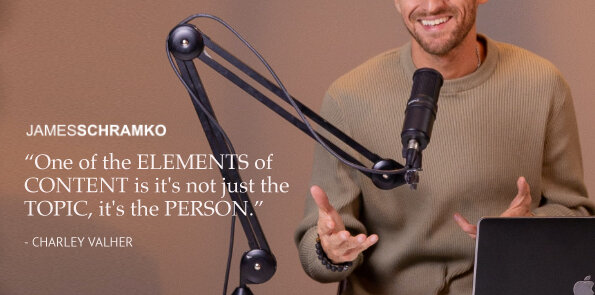
People want to connect with humans, says James. Even with numerous faceless podcasts created via AI, people will still show up to hear from someone they know and trust.
James and Charley agree that AI can be a useful tool to improve the quality of content, but humans are still essential for providing authenticity, integrity, and a unique perspective. They also discuss the popularity of reality TV shows like Big Brother and how people are drawn to following actual people, highlighting the importance of human connection in media.
The stuff that won’t change
James wants to take a step back and look at the things that won’t change. He feels that email, for instance, is a powerful tool that remains relevant in today’s digital landscape.
Email is intimate, says Charley, and continues to be strong. He would almost say that podcast and email were built to go together.
The strategy Charley uses today with email, particularly for his shows, is promoting downloadable resources such as calculators or frameworks. He takes this further by directing people to related podcast or video episodes that will enhance the value of the download, say an episode on using a wealth tracker they provided.
This approach can create a powerful combination of email and podcast that delivers a bigger result.
Charley also reiterates the value of using a cliffhanger strategy to lead people to your show and promote video through paid media channels. Shorts organically on YouTube are also currently great for growth.
James speaks of the ongoing importance of providing educational and instructional content to help people understand why they need something, what it actually is, and how it can help. He cites the example of his previous episode on membership options.
This is the value, too, of creating actionable case studies with steps people can follow and apply to their own business.
Wrapping things up
To close, Charley and James review some aspects of video marketing and podcasting. They mention the importance of creating show notes, providing key points, and offering free resources such as PDFs and checklists to attract subscribers.
They also stress the benefits of having specific and general opt-ins and bridging the gap between the tools people need and the content that is presented to them.
Additionally, our experts talk about the importance of pre-production and post-production efforts in creating engaging content and promoting it effectively.
If you’d like help creating content for your business, Charley’s company ValherMedia is still very much alive and providing that service.
And if you’re at all interested in his financial shows, you’ll find them at businessandinvesting.com and propertyandinvesting.com.
Enjoyed the show? Leave us a review on iTunes



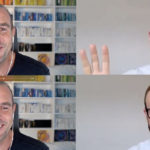





Leave a Reply